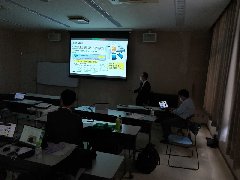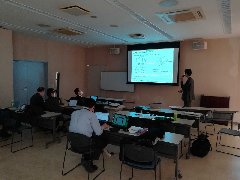1. Convener: Dr. Kengo Nishimoto (Mitsubishi Electric Corporation)
2. Date/time: 13:30 - 17:20, November 2nd, 2021
3. Venue: Nonoichishi Koyusha, Kanazawa city, Ishikawa pref.
(Online participation was available)
4. Registration fee: Free
5. Listed attendees: 14 persons (local participation) , 31 persons (online participation)
6. Technical arrangement: Dr. Kengo Nishimoto (Mitsubishi Electric Corporation)
7. Local arrangement: Prof. Keisuke Noguchi (Kanazawa Institute of Technology)
8. Session title: "Small antenna technologies in the IoT/5G era"
9. Sponsors:
- IEEE MTT-S Nagoya Chapter
- IEEE AP-S Nagoya Chapter
- IEEE VT-S Tokyo/Japan Chapter
- IEEE SSCS Japan Chapter
10. Presentations:
11.Reception:
It held from 18:30 to 20:30 at Ekinokura in Kanazawa station, Kanazawa city, Ishikawa pref. The number of attendees was 13 persons.
12.The Steering committee meeting:
It took place from 13:00 to 13:30 on November 2nd, 2021, at Nonoichishi Koyusha and on online.
13. Concluding Remarks
With the spread of IoT, many terminals are equipped with a wireless communication function, and as the terminals themselves become smaller, the demand for smaller antennas is increasing. In addition, 5G terminals are increasingly required to be equipped with multi-frequency, multi-element antennas to improve communication performance. On the other hand, there are theoretical limits to the miniaturization of antennas, and the gain and bandwidth decrease with miniaturization. Therefore, to meet the demand and approach the limit, the technological progress of small, wideband, and multi-element antennas is desired. At this meeting, we focused on small antenna technologies in the IoT/5G era, discussed intensely the latest trends and issues through lectures, questions and answers, and deepened a common understanding of future prospects.
Prof. Keisuke Fujita (Maebashi Institute of Technology) gave a lecture on the theoretical analysis of spherical and cylindrical helix antennas for IoT applications. The analysis method of the spherical antenna, the maximum radiation efficiency and the Q value were shown. The theoretical limit was clarified, and it was validated that the antenna close to the theoretical limit can be realized by the spherical helix antenna and the cylindrical helix antenna.
Dr. Kengo Nishimoto (Mitsubishi Electric) gave a lecture on small and dual-frequency decoupling circuits for two-element antennas. A small decoupling circuit that can control the excitation distribution of the antenna and a small and low loss dual-frequency decoupling circuit that is integrated with the matching circuit were shown, and its effectiveness were verified by measurement and calculation. We deepened the common understanding about the effect of the decoupling circuit.
Prof. Keisuke Noguchi (Kanazawa Institute of Technology) gave a lecture on the quality factor and broadbanding for solid or planar small antennas. After reconsidering the Q value of the small antenna, the results of wideband design and evaluation by multi-mode resonance were shown and compared with the theoretical limit. In the future, it was shown that research to increase the degree of freedom of polarization with an eye on MIMO is an issue.
Prof. Hisashi Morishita (National Defense Academy of Japan) gave a lecture on the design of a small antenna design with robustness to metal for installation on metal walls. It was shown that the high impedance antenna improves the robustness depending on the direction in which the metal plate approaches. The antenna that can switch the input impedance according to the installation environment was also shown, and it was confirmed that the installation area with low VSWR is expanded.
This meeting greatly contributed to the miniaturization and higher performance of small antennas, and served as a place for participants to understand the actual state-of-the-art R&D situation and share awareness of technical issues and prospects for the future image envisioned by each participant.
To view larger photo, please click above photo then type password.




